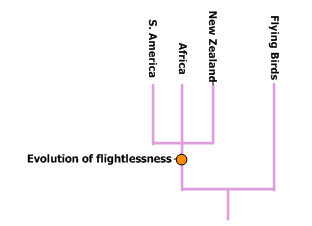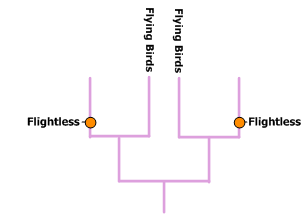Even so here I am writing about another finding where this time genetic methods produced results that fossils and morphological comparisons alone did not anticipate. Large flightless birds of the southern continents like the emu, ostrich, rheas and the kiwi were believed to be more closely related to each other than to other flighted birds. A genetic analysis has apparently redrawn the family tree of these birds.
It was thought that flightlessness evolved just once. I have depicted this scenario in the figure below.

Here flightlessness evolves in a stem or ancestral species. This happens when the southern continents are still part of the super continent Gondwanaland. The stem species gives rise to several descendant species. The flightlessness in each of these descendant species is a plesiomorphy or an ancestral trait inherited from the stem species. As Gondwanaland breaks up different flightless descendant species end up on different continents and diverge in response to the unique conditions.
But the recent genetic analysis indicates a different scenario. There may have been flightless bird species on Gondwanaland but none of them were the common ancestor of all modern southern continent flightless birds. Rather:

Loss of flight evolved several times on different continents independently in different lineages of flying birds. The flightless trait of the modern flightless birds is said to be an apomorphy or a derived trait in each of these lineages.
Why am I not that surprised? Here is what Edward Braun, one of the researchers had to say:
Scientists assumed that a single flightless common ancestor of the ratites lived on the supercontinent of Gondwana, which slowly broke up into Africa, South America, Australia and New Zealand; once divided, the ancestor species evolved slightly in each new location to produce the differences among the present-day ratites
So, the hypothesis that flightless birds formed a monophyletic group with respect to flying birds was never tested using morphological criteria? It seems that a convenient paleo-geographic story was available and so the assumption was made that flightless birds are monophyletic. Does this speak to the limitation of morphological comparisons for understanding evolutionary relationships or is there something else going on? Why was convergence i.e. the independent evolution of similar features never considered a possibility?
Off course the most heretical suggestion is that we still carry an unconscious bias for typological thinking, a tradition of grouping organisms that goes back well before evolutionary thinking. Flightless birds form a group or a type different from flying birds not because we know they are evolutionarily more closely related to each other but simply because they share the distinct trait of losing flight. No evolutionary scientist thinks this way any more.

No comments:
Post a Comment